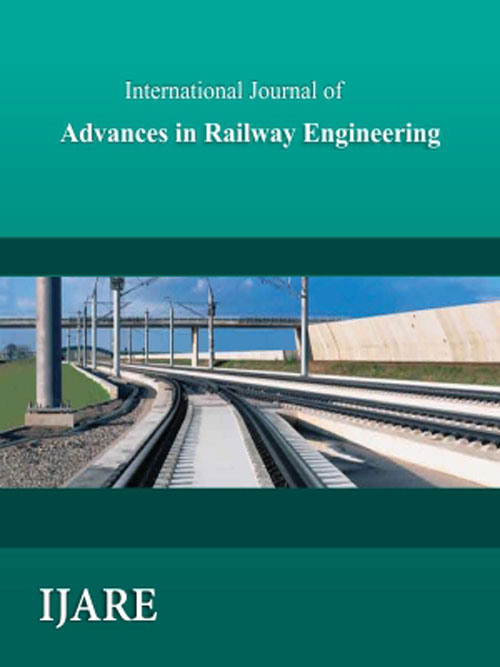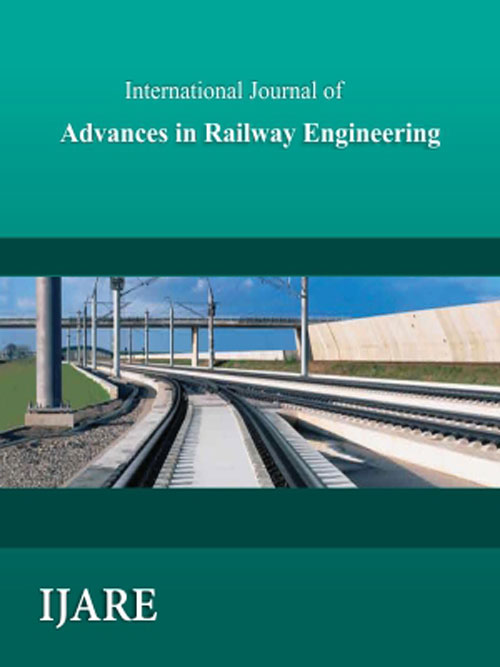فهرست مطالب

International Journal of Advances in Railway Engineering
Volume:2 Issue: 1, Spring 2014
- تاریخ انتشار: 1394/02/14
- تعداد عناوین: 6
-
-
Pages 1-11Regarding increasing importance of tank wagons and efficiency in fluids transportation, their usage is increasing every day. Thus paying attention to their designs just as dynamic analysis of wagons during travelling time is vitally important. In this task, sloshing coefficient as prominent parameter in tank wagons designing has been investigated. To ease of efficient design, theses parameters can cause accurate and economic design. For purpose of derivation of this coefficient, Arbitrary Lagrange-Euler (ALE) method was applied and results were compared with equivalent mechanical method (EM). So, to simulate fluid sloshing inside the tank two different approaches, Finite element method and multi body dynamics were exploited. In lateral and longitudinal simulations, tanker is analyzed in traveling curved track and accelerating respectively. Also, the effects of velocity, irregularities of track and fill ratio on sloshing coefficient were studied. These results are proposed to be used in tank design and related manuals.Keywords: Tank Wagon, Sloshing, Multi body dynamics, ALE method
-
Pages 13-20Car body acceleration is an important factor affecting track safety and ride comfort, which are two primary aspects of railway systems. Though track level is an important source of wagon body acceleration, no quantitative relation between them is available and the aim of this paper is to propose a method to address this issue. To do so, car body acceleration is determined using a 10 DOF simulated wagon, when track level irregularity is applied to its wheels. Results of numerical 2D simulation suggest an increasing trend between track level irregularity and car body acceleration. This trend is also affected by the quality of tracks, as higher acceleration levels are evident in tracks with poor quality condition. To have a more realistic point of view, a case study of Iranian network is carried out in which recorded acceleration and track level data of EM120 recording vehicle are used to determine the trend between them. Acceleration levels obtained through this method are higher than those obtained by simple 2D model, since all affecting factors are introduced. Also, Results suggest that for any value of track level irregularity, acceleration is bounded to an upper and lower level, which are obtained using a linear regression. A new track quality assessment based on recorded car body acceleration level is also proposed.Keywords: Track level irregularity, Car body acceleration, Track quality assessment
-
Pages 21-28In this paper, a neural network model reference adaptive system speed observer is designed, which can be used in speed control of linear induction motors (LIMs). Dynamical equations of LIM have been considered accurate. In other words, the end effect and the electrical losses of the motor have been included in the motor equivalent circuit. Then equations of the reference model and adaptive model have been extracted. Existence of the speed-dependent functions in the reference model causes error in speed estimation. In order to reduce error, the reference model equations are updated unlike the standard MRAS method. The adaptive model equations have also been discrete and they have been rewritten so as to be represented by a linear neural network (ADALINE). On this basis, the so-called back propagation has been used to compute online, in recursive form, the machine linear speed. Finally, the estimated speed is used for motor speed control. The simulations show the efficiency of the method.Keywords: electrical railway, linear induction motor, sensorless control, speed estimation
-
Pages 27-40Foam injection is becoming a standard conditioning agent when tunnelling with an earth-pressure balanced shield, resulting in an increasing interest in this technique. The technique is mostly based on empirical rules and experience. To be able to determine what foam and how may foam has to be injected for different soils, it is necessary to know the mechanical parameters of the foam-water-soil mixture. This paper describes a comprehensive set of tests that has been performed to evaluate the effect that foam, foam types, and foam parameters have on the shear strength of sandy soil. Four different foam agents and one type of polymer were used during the tests. The foam production process was performed by a foam generator, which was constructed by the authors. Shear strength tests were carried out in a conventional direct shear box measuring 60x60 mm. The test results show a decrease in the internal friction angle and an increase in soil compressibility for foamed soil, where the changes are functions of soil gradation, foam types, and foam parameters. It appears that another agent (such as bentonite slurry) needs to be added to coarse-grained soils to condition the soil effectively by increasing the fine content and reducing the number of large voids. The test results also show that the effect of different foaming agents on the shear strength of fine sand is not noticeable.Keywords: EPBM, Foam, Polymer, Shear strength, Dilation
-
Pages 41-58High speed trains are an indispensable part of rapid transportation systems in many countries. As the fastest means of transport on the ground, these trains are extremely sensitive to the terrain and track conditions. Geometrical irregularities and mechanical characteristics of the track, together with inconsistencies in the lane (including bridges that support the track) are considered important parameters in defining performance and functionality for a train-track-bridge system. In this work a model for interaction study on such systems is proposed that introduces the skipping effect of load movement on track assembly. In this model the train system is consisted of rigid bodies and the bridge model is based on the modal approach. The prospect of using TMD devices for vibration control of bridge-train system is also provided in the model. For the track system a multi layered model using elastic foundation concept is adopted. Using this model, the roles of track characteristics in behaviour of train-bridge systems have been studied. Results of analyses show a clear distinction between different track technologies in providing performance and functionality for a typical train-bridge-track system. These results also indicate the effectiveness TMD devices in reducing bridge-track responses at resonance speeds.Keywords: vehicle, bridge interaction, high, speed trains, load skipping, track dynamics, vibration control
-
Pages 59-71The goal of this paper is to develop a Decision Support System (DSS) as a journey planner in complex and large multimodal urban network called Rahyar. Rahyar attempts to identify the most desirable itinerary among all feasible alternatives. The desirability of an itinerary is measured by a disutility function, which is defined as a weighted sum of some criteria. The weights represent travelers’ preferences to the attributes (e.g., total travel time and monetary cost). The journey-planning problem in Rahyar is developed as a multi-destination, multi-criteria shortest tour problem with time windows. This problem is one of the important and practical problems in several fields including transportation. This problem is structured based on a Traveling Salesman Problem with Time Windows (TSPTW). Three modes of walking, bus, and subway are assumed to be used for traveling between points. It is demonstrated that Rahyar is capable of effectively generating alternative itineraries for a tour that involves multiple trips and multiple modes, with complex constraints. The planner serves as a practical tool for travelers in itinerary planning.Keywords: Journey Planning, Multimodal Transportation, Time windows, Decision Support System, Multi, Destination Trip, Public Transportation


